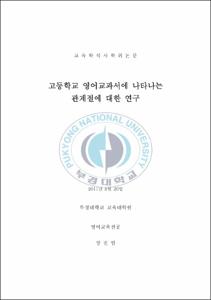고등학교 영어교과서에 나타나는 관계절에 대한 연구
- Alternative Title
- A Corpus-Based Analysis of the Uses of Relative Pronouns in High School English Textbooks
- Abstract
- The purpose of this study is to examine the uses of the relative pronouns in High School English textbooks and to find out if they are properly used in these textbooks by comparing them to relative pronouns in other reading materials, representing real English. In order to achieve these goals, a corpus of High School textbooks and a corpus of other reading materials for real English were separately made to see if relative pronouns in high school textbooks reflect the uses of relative pronouns in real English.
Research Questions related to this study are as follows:
1. Does the frequency of relative pronouns in High School English textbooks published by the 2008 Revised Education Curriculum correspond with the frequency of real English?
2. What is the frequency of relative pronouns in both restrictive relative clause and non-restrictive relative clause?
3. What is the frequency difference between the nominative relative pronouns and the objective relative pronouns?
4. What is the frequency of the objective relative pronoun that which has a person as an antecedent?
This research was conducted as follows. First of all, full text from 5 High School textbooks were saved as text file and examined to see the frequency of relative pronouns : who, whose, whom, which and that. Objective relative pronouns that are deleted were counted manually.
Second of all, to make the corpus of relative pronouns in real English, full text from Holes, Readers Digest and 124 Articles in New York Times were saved as text file and examined as was stated above.
The results of the study are as follows:
First, the total proportions of relative pronouns in textbooks and other reading materials for real English were almost the same at about 12%. The most common relative pronoun that appeared in both groups was that, 34.46% in textbooks and 34.55% in other reading materials. Therefore, High School English textbooks reflect the relative pronouns that are used in real English.
Second, in the analysis results of relative pronoun types, the relative pronoun who and which have different frequencies compared with the corpus of reading materials for real English. Except these two relatives, the rest of relative pronouns in textbooks are used properly.
Third, in the analysis results of relative pronoun use, the frequency of the subjective pronoun who in non-restrictive clauses varied considerably in textbooks and reading materials for real English. The frequency in reading materials was 9.01%, and only 2% in 5 textbooks. Therefore, High School English textbooks don't reflect the relative pronoun use, compared to the corpus of real English.
Finally, in the analysis results of relative pronouns case, the frequency of the nominative case was much higher than the objective case in both the corpus of textbooks and the corpus of reading materials for real English.
In conclusion, this study shows the uses and frequency of relative pronouns in textbooks analyzed by corpus program. The results indicate that most of them reflect the real English presented by the corpus of reading materials for real English. But most textbooks do not seem to have paid much attention to the subjective relative who in non-restrictive clauses and the subjective relative which in restrictive clauses, which have varied greatly in frequency.
This study suggests that it is necessary to refer to the group of other materials in order to supplement the parts that are not presented in textbooks. So learners can be exposed to and then use more natural English in real communication. In addition, there have been few studies on why people prefer the nominative case to the objective case when it comes to using the relative pronouns. And there also have been few studies on what factors affect the choice of antecedents, using relative pronoun that. Therefore, more studies on relative pronouns should be done to make learners better understand the use of relative pronouns.
- Issued Date
- 2011
- Awarded Date
- 2011. 8
- Type
- Dissertation
- Keyword
- 관계대명사
- Publisher
- 부경대학교 교육대학원
- Affiliation
- 부경대학교 교육대학원
- Department
- 교육대학원 영어교육전공
- Advisor
- 박순혁
- Table Of Contents
- Ⅰ. 서 론 1
1.1 연구 필요성 및 목적 1
1.2 연구 과제 3
1.3 연구의 범위와 방법 3
1.4 연구의 제한점 4
Ⅱ. 이론적 배경 5
2.1 관계대명사의 용법 5
2.2 관계절에 대한 ESL/EFL 학습자들의 문제 19
2.3 코퍼스 언어학 21
2.4 한국어와 영어 관계절의 비교 26
2.5 선행연구 29
Ⅲ. 연구 방법 33
3.1 분석대상 33
3.2 분석방법 34
Ⅳ. 분석결과 37
4.1 교과서 코퍼스와 교과서외 코퍼스 기초 분석 37
4.1.1 교과서 코퍼스에 나타난 관계대명사의 분포현황 37
4.1.2 교과서외 읽기자료 코퍼스에 나타난 관계대명사의 분포현황 40
4.1.3 교과서 코퍼스와 교과서외 읽기자료 코퍼스 비교 43
4.2 관계대명사의 유형별 분석 43
4.2.1 관계대명사 전체 분포현황 43
4.2.2 관계대명사 who의 분석 45
4.2.3 관계대명사 which의 분석 46
4.2.4 관계대명사 whom의 분석 47
4.2.5 관계대명사 whose의 분석 47
4.2.6 관계대명사 that의 분석 48
4.2.7 관계대명사의 생략 분석 50
4.3 관계대명사의 용법별 분석 51
4.3.1 주격관계대명사 who의 제한절과 비제한절 분석 52
4.3.2 주격관계대명사 which의 제한절과 비제한절 분석 53
4.4 관계대명사의 격별 분석 54
Ⅳ. 결론 및 제언 57
참고문헌 61
- Degree
- Master
- Files in This Item:
-
-
Download
 고등학교 영어교과서에 나타나는 관계절에 대한 연구.pdf
기타 데이터 / 2.54 MB / Adobe PDF
고등학교 영어교과서에 나타나는 관계절에 대한 연구.pdf
기타 데이터 / 2.54 MB / Adobe PDF
-
Items in Repository are protected by copyright, with all rights reserved, unless otherwise indicated.